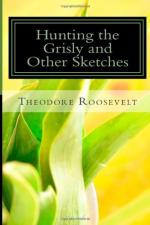Yet even the slaughter wrought by man in certain localities does not seem adequate to explain the scarcity or extinction of wolves, throughout the country at large. In most places they are not followed any more eagerly than are the other large beasts of prey, and they are usually followed with less success. Of all animals the wolf is the shyest and hardest to slay. It is almost or quite as difficult to still-hunt as the cougar, and is far more difficult to kill with hounds, traps, or poison; yet it scarcely holds its own as well as the great cat, and it does not begin to hold its own as well as the bear, a beast certainly never more readily killed, and one which produces fewer young at a birth. Throughout the East the black bear is common in many localities from which the wolf has vanished completely. It at present exists in very scanty numbers in northern Maine and the Adirondacks; is almost or quite extinct in Pennsylvania; lingers here and there in the mountains from West Virginia to east Tennessee, and is found in Florida; but is everywhere less abundant than the bear. It is possible that this destruction of the wolves is due to some disease among them, perhaps to hydrophobia, a terrible malady from which it is known that they suffer greatly at times. Perhaps the bear is helped by its habit of hibernating, which frees it from most dangers during winter; but this cannot be the complete explanation, for in the South it does not hibernate, and yet holds its own as well as in the North. What makes it all the more curious that the American wolf should disappear sooner than the bear is that the reverse is the case with the allied species of Europe, where the bear is much sooner killed out of the land.
Indeed the differences of this sort between nearly related animals are literally inexplicable. Much of the difference in temperament between such closely allied species as the American and European bears and wolves is doubtless due to their surroundings and to the instincts they have inherited through many generations; but for much of the variation it is not possible to offer any explanation. In the same way there are certain physical differences for which it is very hard to account, as the same conditions seem to operate in directly reverse ways with different animals. No one can explain the process of natural selection which has resulted in the otter of America being larger than the otter of Europe, while the badger is smaller; in the mink being with us a much stouter animal than its Scandinavian and Russian kinsman, while the reverse is true of our sable or pine marten. No one can say why the European red deer should be a pigmy compared to its giant brother, the American wapiti; why the Old World elk should average smaller in size than the almost indistinguishable New World moose; and yet the bison of Lithuania and the Caucasus be on the whole larger and more formidable than its American cousin. In the same way no one can tell why under like conditions some game, such as the white goat and the spruce grouse, should be tamer than other closely allied species, like the mountain sheep and ruffled grouse. No one can say why on the whole the wolf of Scandinavia and northern Russia should be larger and more dangerous than the average wolf of the Rocky Mountains, while between the bears of the same regions the comparison must be exactly reversed.




